For this church:    |
|
 The Easter The EasterSepulchre |
 Detail of the carving Detail of the carvingon the Easter Sepulchre |
Easter Sepulchre
The Easter Sepulchre is in the north wall of the chancel, with crocketed niches but no figures remain.
 Double piscina Double piscina |
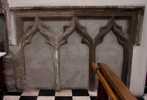 The outline of the The outline of theformer sedilia |
Piscina & Sedilia
The piscina was carved from a single block of stone and has been restored and reset at a higher level. The Sedilia do not survive, but there is an outline where the seats were.
Nave
 Detail of the carving Detail of the carvingon the chancel screen |
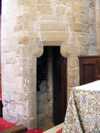 Entrance to Entrance tothe old stairs |
Chancel Screen
The current screen was erected in the 1920s. The old oak screen was demolished in the 1820s, and before that a stone screen had stood in the sixteenth century. The new screen was given by Colonel Frank Seely in 1924, along with choir stalls, the marble pavement in the chancel and the reredos. The rood loft stairs remain, but are now concealed with a doorway blocked up at the top right hand side of the screen. This connected through the right hand pillar by way of a circular staircase coming out on the right hand of the pillar, forming the approach to the original rood loft for acolytes and servers who would use the stairs when trimming the candles kept burning in front of statues, or ringing the sacring bell when the Host was elevated, and in order to veil the crucifixes with unbleached linen at Passiontide.
 Lectern
Lectern
The oak eagle lectern was bought in 1899 by the proceeds of the sale of work made by the Ladies Sewing Circle.
 Pulpit
Pulpit
On the front of the late nineteenth century pulpit there is an IHS monogram carved.
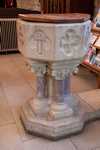 The font The font |
 Detail of the Detail of thefont lid |
Font
The font was installed and dedicated by the Bishop of Derby on 10 May 1899. It is octagonal, with six brown marble pillars, with Christian symbols on each face of the rim. It has a wooden lid, with a carving of Mary and the infant Jesus on it. The lid was given in memory of Jesse Jarvis 1901-91.
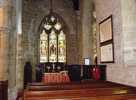 The St Katherine The St KatherineChapel |
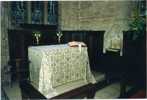 Detail of the Detail of thealtar |
St Katherine’s Chapel
After the First World War St Katherine’s Chapel was refurbished and rededicated in memory of those who had lost their lives. Wooden panelling, a table taken from the vestry, and an altar rail were installed. In 1976 the Mothers’ Union bought the altar frontal.






